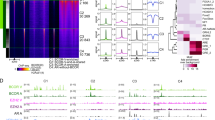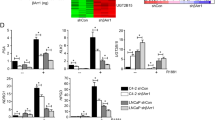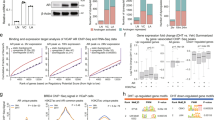Abstract
The processes associated with transition to castration-resistant prostate cancer (PC) growth are not well understood. Cellular senescence is a stable cell cycle arrest that occurs in response to sublethal stress. It is often overcome in malignant transformation to confer a survival advantage. CCAAT/Enhancer Binding Protein (C/EBP) β function is frequently deregulated in human malignancies and interestingly, androgen-sensitive PC cells express primarily the liver-enriched inhibitory protein isoform. We found that C/EBPβ expression is negatively regulated by androgen receptor (AR) activity and that treatment of androgen-sensitive cell lines with anti-androgens increases C/EBPβ mRNA and protein levels. Accordingly, we also find that C/EBPβ levels are significantly elevated in primary PC samples from castration-resistant compared with therapy-naive patients. Chromatin immunoprecipitation demonstrated enhanced binding of the AR to the proximal promoter of the CEBPB gene in the presence of dihydroxytestosterone. Upon androgen deprivation, induction of C/EBPβ is facilitated by active transcription as evident by increased histone 3 acetylation at the C/EBPβ promoter. Also, the androgen agonist R1881 suppresses the activity of a CEBPB promoter reporter. Loss of C/EBPβ expression prevents growth arrest following androgen deprivation or anti-androgen challenge. Accordingly, suppression of C/EBPβ under low androgen conditions results in reduced expression of senescence-associated secretory genes, significantly decreased number of cells displaying heterochromatin foci and increased numbers of Ki67-positive cells. Ectopic expression of C/EBPβ caused pronounced morphological changes, reduced PC cell growth and increased the number of senescent LNCaP cells. Lastly, we found that senescence contributes to PC cell survival under androgen deprivation, and C/EBPβ-deficient cells were significantly more susceptible to killing by cytotoxic chemotherapy following androgen deprivation. Our data demonstrate that upregulation of C/EBPβ is critical for complete maintenance of androgen deprivation-induced senescence and that targeting C/EBPβ expression may synergize with anti-androgen or chemotherapy in eradicating PC.
This is a preview of subscription content, access via your institution
Access options
Subscribe to this journal
Receive 50 print issues and online access
$259.00 per year
only $5.18 per issue
Buy this article
- Purchase on Springer Link
- Instant access to full article PDF
Prices may be subject to local taxes which are calculated during checkout








Similar content being viewed by others
References
American Cancer Society. Cancer Facts and Figures 2013, 2013. http://www.cancer.org/acs/groups/content/@epidemiologysurveilance/documents/document/acspc-036845.pdf.
Nelson WG, De Marzo AM, Isaacs WB . Prostate cancer. N Engl J Med 2003; 349: 366–381.
Denmeade SR, Isaacs JT . Activation of programmed (apoptotic) cell death for the treatment of prostate cancer. Adv Pharmacol 1996; 35: 281–306.
Denmeade SR, Lin XS, Isaacs JT . Role of programmed (apoptotic) cell death during the progression and therapy for prostate cancer. Prostate 1996; 28: 251–265.
Burton DG, Giribaldi MG, Munoz A, Halvorsen K, Patel A, Jorda M et al. Androgen deprivation-induced senescence promotes outgrowth of androgen-refractory prostate cancer cells. PLoS One 2013; 8: e68003.
Ewald JA, Desotelle JA, Church DR, Yang B, Huang W, Laurila TA et al. Androgen deprivation induces senescence characteristics in prostate cancer cells in vitro and in vivo. Prostate 2013; 73: 337–345.
Pernicova Z, Slabakova E, Kharaishvili G, Bouchal J, Kral M, Kunicka Z et al. Androgen depletion induces senescence in prostate cancer cells through down-regulation of Skp2. Neoplasia 2011; 13: 526–536.
Sebastian T, Malik R, Thomas S, Sage J, Johnson PF . C/EBPbeta cooperates with RB:E2F to implement Ras(V12)-induced cellular senescence. EMBO J 2005; 24: 3301–3312.
Calkhoven CF, Muller C, Leutz A . Translational control of C/EBPalpha and C/EBPbeta isoform expression. Genes Dev 2000; 14: 1920–1932.
Timchenko NA, Welm AL, Lu X, Timchenko LT . CUG repeat binding protein (CUGBP1) interacts with the 5' region of C/EBPbeta mRNA and regulates translation of C/EBPbeta isoforms. Nucleic Acids Res 1999; 27: 4517–4525.
Tanabe A, Kumahara C, Osada S, Nishihara T, Imagawa M . Gene expression of CCAAT/enhancer-binding protein delta mediated by autoregulation is repressed by related gene family proteins. Biol Pharm Bull 2000; 23: 1424–1429.
Christenson LK, Johnson PF, McAllister JM, Strauss JF 3rd . CCAAT/enhancer-binding proteins regulate expression of the human steroidogenic acute regulatory protein (StAR) gene. J Biol Chem 1999; 274: 26591–26598.
Zhou J, Gurates B, Yang S, Sebastian S, Bulun SE . Malignant breast epithelial cells stimulate aromatase expression via promoter II in human adipose fibroblasts: an epithelial-stromal interaction in breast tumors mediated by CCAAT/enhancer binding protein beta. Cancer Res 2001; 61: 2328–2334.
Bagchi MK, Mantena SR, Kannan A, Bagchi IC . Control of uterine cell proliferation and differentiation by C/EBPbeta: functional implications for establishment of early pregnancy. Cell cycle 2006; 5: 922–925.
Boruk M, Savory JG, Hache RJ . AF-2-dependent potentiation of CCAAT enhancer binding protein beta-mediated transcriptional activation by glucocorticoid receptor. Mol Endocrinol 1998; 12: 1749–1763.
Mantena SR, Kannan A, Cheon YP, Li Q, Johnson PF, Bagchi IC et al. C/EBPbeta is a critical mediator of steroid hormone-regulated cell proliferation and differentiation in the uterine epithelium and stroma. Proc Natl Acad Sci U S A 2006; 103: 1870–1875.
Stein B, Yang MX . Repression of the interleukin-6 promoter by estrogen receptor is mediated by NF-kappa B and C/EBP beta. Mol Cell Biol 1995; 15: 4971–4979.
Zhang J, Gonit M, Salazar MD, Shatnawi A, Shemshedini L, Trumbly R et al. C/EBPalpha redirects androgen receptor signaling through a unique bimodal interaction. Oncogene 2010; 29: 723–738.
Jia L, Berman BP, Jariwala U, Yan X, Cogan JP, Walters A et al. Genomic androgen receptor-occupied regions with different functions, defined by histone acetylation, coregulators and transcriptional capacity. PLoS One 2008; 3: e3645.
Wang W, Bergh A, Damber JE . Increased expression of CCAAT/enhancer-binding protein beta in proliferative inflammatory atrophy of the prostate: relation with the expression of COX-2, the androgen receptor, and presence of focal chronic inflammation. Prostate 2007; 67: 1238–1246.
Kim MH, Fields J . Translationally regulated C/EBP beta isoform expression upregulates metastatic genes in hormone-independent prostate cancer cells. Prostate 2008; 68: 1362–1371.
Kim MH, Minton AZ, Agrawal V . C/EBPbeta regulates metastatic gene expression and confers TNF-alpha resistance to prostate cancer cells. Prostate 2009; 69: 1435–1447.
Collado M, Serrano M . Senescence in tumours: evidence from mice and humans. Nat Rev Cancer 2010; 10: 51–57.
Coppe JP, Desprez PY, Krtolica A, Campisi J . The senescence-associated secretory phenotype: the dark side of tumor suppression. Annu Rev Pathol 2010; 5: 99–118.
Huggins CJ, Malik R, Lee S, Salotti J, Thomas S, Martin N et al. C/EBPgamma suppresses senescence and inflammatory gene expression by heterodimerizing with C/EBPbeta. Mol Cell Biol 2013; 33: 3242–3258.
Orjalo AV, Bhaumik D, Gengler BK, Scott GK, Campisi J . Cell surface-bound IL-1alpha is an upstream regulator of the senescence-associated IL-6/IL-8 cytokine network. Proc Natl Acad Sci U S A 2009; 106: 17031–17036.
Rhodes DR, Kalyana-Sundaram S, Mahavisno V, Varambally R, Yu J, Briggs BB et al. Oncomine 3.0: genes, pathways, and networks in a collection of 18,000 cancer gene expression profiles. Neoplasia 2007; 9: 166–180.
Grasso CS, Wu YM, Robinson DR, Cao X, Dhanasekaran SM, Khan AP et al. The mutational landscape of lethal castration-resistant prostate cancer. Nature 2012; 487: 239–243.
Yusa K, Zhou L, Li MA, Bradley A, Craig NL . A hyperactive piggyBac transposase for mammalian applications. Proc Natl Acad Sci U S A 2011; 108: 1531–1536.
Cermak T, Doyle EL, Christian M, Wang L, Zhang Y, Schmidt C et al. Efficient design and assembly of custom TALEN and other TAL effector-based constructs for DNA targeting. Nucleic Acids Res 2011; 39: e82.
Bedell VM, Wang Y, Campbell JM, Poshusta TL, Starker CG, Krug RG 2nd et al. In vivo genome editing using a high-efficiency TALEN system. Nature 2012; 491: 114–118.
Kurz DJ, Decary S, Hong Y, Erusalimsky JD . Senescence-associated (beta)-galactosidase reflects an increase in lysosomal mass during replicative ageing of human endothelial cells. J Cell Sci 2000; 113: 3613–3622.
Acosta JC, O'Loghlen A, Banito A, Guijarro MV, Augert A, Raguz S et al. Chemokine signaling via the CXCR2 receptor reinforces senescence. Cell 2008; 133: 1006–1018.
Kuilman T, Michaloglou C, Vredeveld LC, Douma S, van Doorn R, Desmet CJ et al. Oncogene-induced senescence relayed by an interleukin-dependent inflammatory network. Cell 2008; 133: 1019–1031.
Narita M, Nunez S, Heard E, Narita M, Lin AW, Hearn SA et al. Rb-mediated heterochromatin formation and silencing of E2F target genes during cellular senescence. Cell 2003; 113: 703–716.
Lehmann BD, Paine MS, Brooks AM, McCubrey JA, Renegar RH, Wang R et al. Senescence-associated exosome release from human prostate cancer cells. Cancer Res 2008; 68: 7864–7871.
Cahu J, Bustany S, Sola B . Senescence-associated secretory phenotype favors the emergence of cancer stem-like cells. Cell Death Dis 2012; 3: e446.
Sharma NL, Massie CE, Ramos-Montoya A, Zecchini V, Scott HE, Lamb AD et al. The androgen receptor induces a distinct transcriptional program in castration-resistant prostate cancer in man. Cancer Cell 2013; 23: 35–47.
Cai C, He HH, Chen S, Coleman I, Wang H, Fang Z et al. Androgen receptor gene expression in prostate cancer is directly suppressed by the androgen receptor through recruitment of lysine-specific demethylase 1. Cancer Cell 2011; 20: 457–471.
Shang Y, Myers M, Brown M . Formation of the androgen receptor transcription complex. Mol Cell 2002; 9: 601–610.
Svensson C, Ceder J, Iglesias-Gato D, Chuan YC, Pang ST, Bjartell A et al. REST mediates androgen receptor actions on gene repression and predicts early recurrence of prostate cancer. Nucleic Acids Res 2013; 42: 999–1015.
Svensson C, Ceder J, Iglesias-Gato D, Chuan YC, Pang ST, Bjartell A et al. REST mediates androgen receptor actions on gene repression and predicts early recurrence of prostate cancer. Nucleic Acids Res 2014; 42: 999–1015.
Lu S, Jenster G, Epner DE . Androgen induction of cyclin-dependent kinase inhibitor p21 gene: role of androgen receptor and transcription factor Sp1 complex. Mol Endocrinol 2000; 14: 753–760.
Yuan H, Gong A, Young CY . Involvement of transcription factor Sp1 in quercetin-mediated inhibitory effect on the androgen receptor in human prostate cancer cells. Carcinogenesis 2005; 26: 793–801.
Bavik C, Coleman I, Dean JP, Knudsen B, Plymate S, Nelson PS . The gene expression program of prostate fibroblast senescence modulates neoplastic epithelial cell proliferation through paracrine mechanisms. Cancer Res 2006; 66: 794–802.
Dean JP, Nelson PS . Profiling influences of senescent and aged fibroblasts on prostate carcinogenesis. Br J Cancer 2008; 98: 245–249.
Manna S, Singha B, Phyo SA, Gatla HR, Chang TP, Sanacora S et al. Proteasome inhibition by bortezomib increases IL-8 expression in androgen-independent prostate cancer cells: the role of IKKalpha. J Immunol 2013; 191: 2837–2846.
Seaton A, Scullin P, Maxwell PJ, Wilson C, Pettigrew J, Gallagher R et al. Interleukin-8 signaling promotes androgen-independent proliferation of prostate cancer cells via induction of androgen receptor expression and activation. Carcinogenesis 2008; 29: 1148–1156.
MacManus CF, Pettigrew J, Seaton A, Wilson C, Maxwell PJ, Berlingeri S et al. Interleukin-8 signaling promotes translational regulation of cyclin D in androgen-independent prostate cancer cells. Mol Cancer Res 2007; 5: 737–748.
Kawabata R, Oie S, Takahashi M, Kanayama H, Oka T, Itoh K . Up-regulation of insulin-like growth factor-binding protein 3 by 5-fluorouracil (5-FU) leads to the potent anti-proliferative effect of androgen deprivation therapy combined with 5-FU in human prostate cancer cell lines. Int J Oncol 2011; 38: 1489–1500.
Mehta HH, Gao Q, Galet C, Paharkova V, Wan J, Said J et al. IGFBP-3 is a metastasis suppression gene in prostate cancer. Cancer Res 2011; 71: 5154–5163.
Henshall SM, Quinn DI, Lee CS, Head DR, Golovsky D, Brenner PC et al. Overexpression of the cell cycle inhibitor p16INK4A in high-grade prostatic intraepithelial neoplasia predicts early relapse in prostate cancer patients. Clin Cancer Res 2001; 7: 544–550.
Lee CT, Capodieci P, Osman I, Fazzari M, Ferrara J, Scher HI et al. Overexpression of the cyclin-dependent kinase inhibitor p16 is associated with tumor recurrence in human prostate cancer. Clin Cancer Res 1999; 5: 977–983.
Zhang Z, Rosen DG, Yao JL, Huang J, Liu J . Expression of p14ARF, p15INK4b, p16INK4a, and DCR2 increases during prostate cancer progression. Mod Pathol 2006; 19: 1339–1343.
Baretton GB, Klenk U, Diebold J, Schmeller N, Lohrs U . Proliferation- and apoptosis-associated factors in advanced prostatic carcinomas before and after androgen deprivation therapy: prognostic significance of p21/WAF1/CIP1 expression. Br J Cancer 1999; 80: 546–555.
Martinez LA, Yang J, Vazquez ES, Rodriguez-Vargas Mdel C, Olive M, Hsieh JT et al. p21 modulates threshold of apoptosis induced by DNA-damage and growth factor withdrawal in prostate cancer cells. Carcinogenesis 2002; 23: 1289–1296.
Steinman RA, Johnson DE . p21WAF1 prevents down-modulation of the apoptotic inhibitor protein c-IAP1 and inhibits leukemic apoptosis. Mol Med 2000; 6: 736–749.
Paz-Priel I, Houng S, Dooher J, Friedman AD . C/EBPalpha and C/EBPalpha oncoproteins regulate nfkb1 and displace histone deacetylases from NF-kappaB p50 homodimers to induce NF-kappaB target genes. Blood 2011; 117: 4085–4094.
Paz-Priel I, Cai DH, Wang D, Kowalski J, Blackford A, Liu H et al. CCAAT/enhancer binding protein alpha (C/EBPalpha) and C/EBPalpha myeloid oncoproteins induce bcl-2 via interaction of their basic regions with nuclear factor-kappaB p50. Mol Cancer Res 2005; 3: 585–596.
Wang X, Scott E, Sawyers CL, Friedman AD . C/EBPalpha bypasses granulocyte colony-stimulating factor signals to rapidly induce PU.1 gene expression, stimulate granulocytic differentiation, and limit proliferation in 32D cl3 myeloblasts. Blood 1999; 94: 560–571.
Debacq-Chainiaux F, Erusalimsky JD, Campisi J, Toussaint O . Protocols to detect senescence-associated beta-galactosidase (SA-betagal) activity, a biomarker of senescent cells in culture and in vivo. Nat Protoc 2009; 4: 1798–1806.
Acknowledgements
This research was supported by grants from the St Baldrick’s Foundation (to IP-P), the Mitchell Foundation (to IP-P), the Walsh Prostate Cancer Research Fund (to IP-P and ADF), the Samuel Waxman Cancer Research Foundation (to ADF), Department of Defense grant PC131609 (to DJB), National Institutes of Health T32 CA60441 (to TB), the Giant Food Children’s Cancer Research Fund and P30 CA006973.
Author Contributions
DJB designed and performed the research, analyzed data and wrote the manuscript; JZ and TB performed the research; SRD designed the research and analyzed data; ADF designed the research, analyzed data and wrote the manuscript; IP-P designed and performed the research, analyzed data and wrote the manuscript.
Author information
Authors and Affiliations
Corresponding author
Ethics declarations
Competing interests
The authors declare no conflict of interest.
Rights and permissions
About this article
Cite this article
Barakat, D., Zhang, J., Barberi, T. et al. CCAAT/Enhancer binding protein β controls androgen-deprivation-induced senescence in prostate cancer cells. Oncogene 34, 5912–5922 (2015). https://doi.org/10.1038/onc.2015.41
Received:
Revised:
Accepted:
Published:
Issue Date:
DOI: https://doi.org/10.1038/onc.2015.41
This article is cited by
-
IGF2 deficiency promotes liver aging through mitochondrial dysfunction and upregulated CEBPB signaling in d-galactose-induced aging mice
Molecular Medicine (2023)
-
Castration promotes the browning of the prostate tumor microenvironment
Cell Communication and Signaling (2023)
-
Distinct mechanisms mediating therapy-induced cellular senescence in prostate cancer
Cell & Bioscience (2022)
-
Transcriptomic analysis of castration, chemo-resistant and metastatic prostate cancer elucidates complex genetic crosstalk leading to disease progression
Functional & Integrative Genomics (2021)
-
PARP1 rs1805407 Increases Sensitivity to PARP1 Inhibitors in Cancer Cells Suggesting an Improved Therapeutic Strategy
Scientific Reports (2019)



